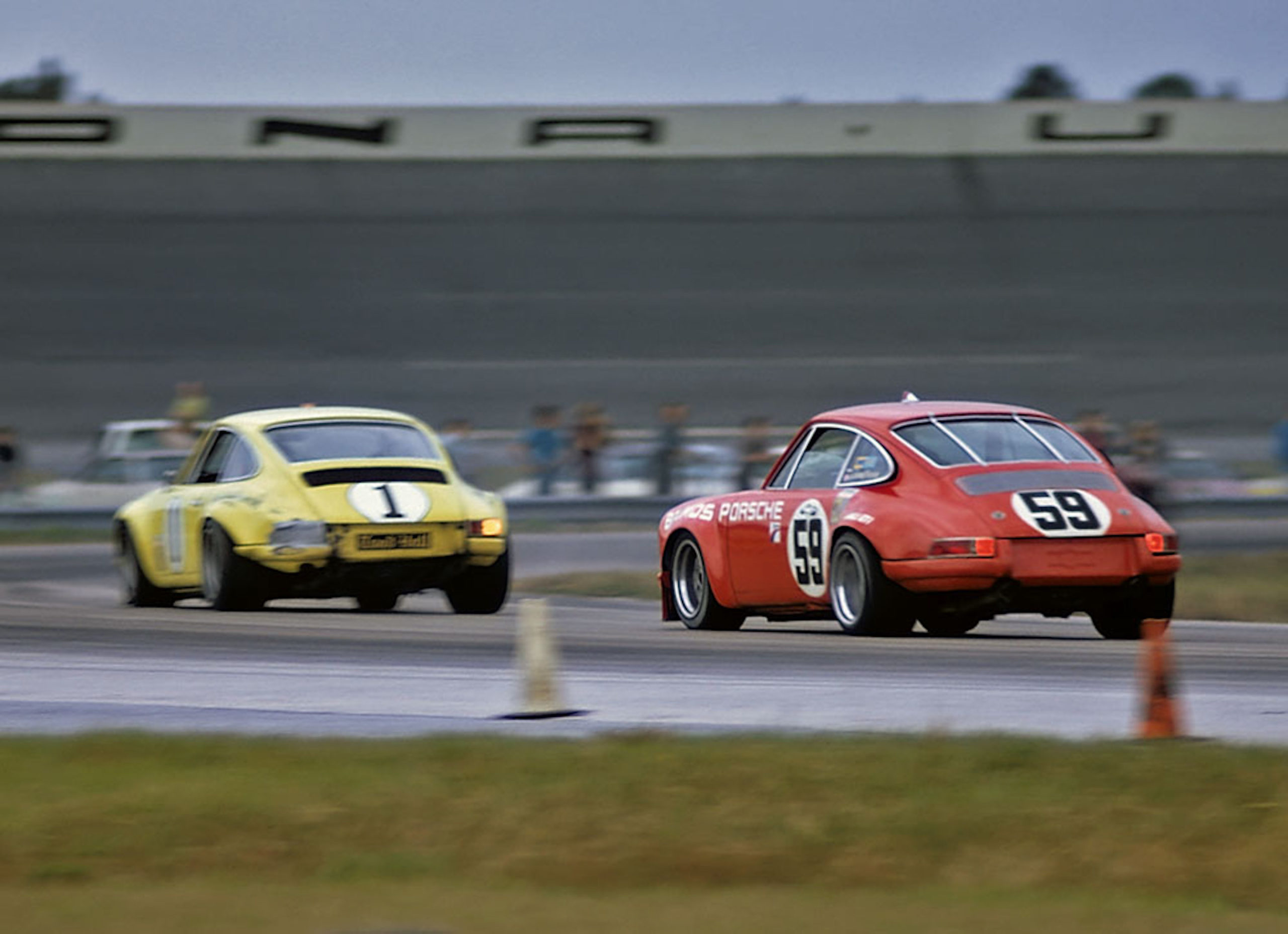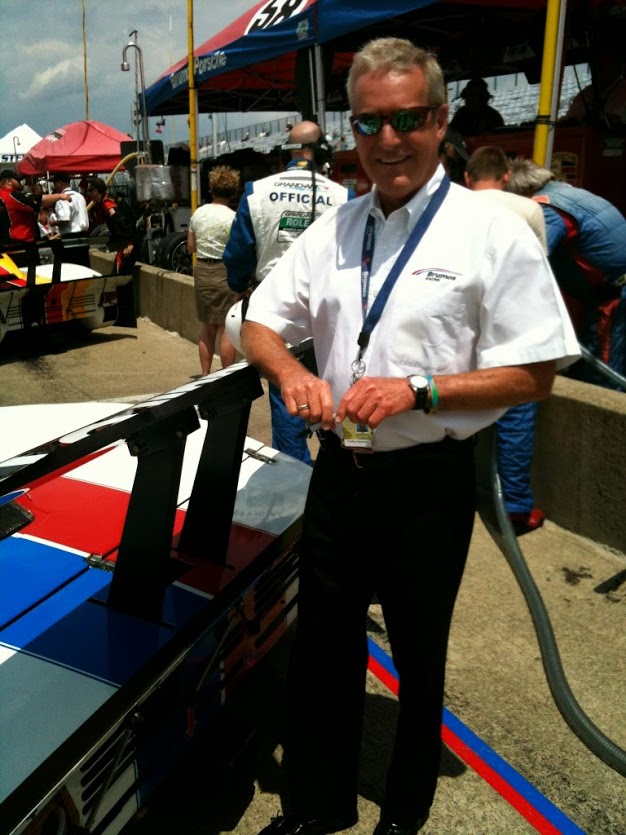by Luis Martinez
After trying to promote formula cars on ovals for its first couple of years, IMSA decided to switch its show to Grand Touring (GT) cars in 1971. The first IMSA GT race, the Danville 300, took place at Virginia International Raceway (VIR) on April 18, 1971. One of the avid spectators at the inaugural event was a U.S. Army Commanding Officer from Fort Lee, VA. The C.O. enjoyed that Sunday’s 3-hour race and the next day the Fort Lee Army Base newspaper, Fort Lee Traveller, announced the results. The C.O. discovered that one of the winning drivers of the #59 Brumos Porsche-Audi that not only won the GTU class but finished first overall was an Army conscript in his command – Army Specialist 4th Class Harris “Hurley” Haywood. Curious about this remarkable find, he summoned Haywood to present himself. When informed that he had been called, Haywood exclaimed, “Oh, (bleep)!”. Did Haywood, an active serviceman and Vietnam veteran, ask for leave to register as co-driver with racing veteran Peter Gregg? The rising IMSA Co-Champion replied with a grin: “I didn’t really ask for leave, I just sort of went.” Twenty-two year old Haywood went and chatted with his superior about the race. The C.O., realizing the talent and potential that Haywood exhibited during the race, comforted his conscript: “We have to accelerate your process-out paperwork!” How’s that for the quick application of a racing term to Army protocols?
One may ask, how did Haywood progress so quickly in life to run in front of the field for a win at the inaugural IMSA GT race? Two salient factors were in play: Haywood’s driving talent (schooled on his grandmother’s farm in Illinois), and an observant, experienced racer who recognized that talent and hired him. Haywood had often stayed at his grandmother’s farm. While there, he drove farm equipment and cars on private land learning handling techniques and getting a wheel ahead of his suburban peers. Meantime, Peter Gregg, a Harvard graduate and Navy Intelligence officer eight years Haywood’s senior, had become a successful Porsche racer. Having built an admirable racing portfolio in the middle of the 1960s, Gregg purchased an automobile dealership in Jacksonville, Florida in 1965, from Hubert Brundage – Brundage Motors. The cable address for this dealership was BRUMOS.
In the late 60’s Haywood was at college in Florida and had bought a used Corvette to compete at local autocross events. At one particular event, the experienced racer, Gregg, was also participating but the younger Haywood beat him anyway. Gregg normally won everything he entered so he decided to meet the talented youth. A friendship then ensued, a partnership that began with Gregg and Haywood collaborating to drive in the Six-Hour International Championship of Makes at Watkins Glen in 1969, winning the GT 2.0 class in Haywood’s orange #58 Porsche 911S.
But then war intervened. Haywood’s draft number came up for compulsory military service. He served a tour of duty in Can Tho, south of Saigon. While serving in Vietnam, Haywood learned a lot about situational awareness – constantly adjusting to unrelenting change while literally dodging bullets. These are lessons that he carried to podium finishes for decades as a highly successful endurance race driver.
In its inaugural year, IMSA’s classification of GTU was aligned with FIA Group 2 regulations for grand touring-type cars with engines of 2.5L displacement or less (the letter U referring to “under”). With so many cars to choose from, why choose the 914-6 for 1971? Haywood responds: “The 914 GT was a ton of fun to drive. The engine is just under 2.5 liters rated at 242 hp with two Weber triple-throat carburetors. It’s caged to stiffen the chassis, and Peter drilled holes in the door panels to lighten it. It had a dry weight of 2,098 lbs with a racing suspension, a 5-speed manual transmission, and 911-type calipers. Rear tires are oversized and fit in the enlarged, squared-off wheel wells. The tires were Goodyear, 7.5 inches in front and 8.5 rear, on 15-inch wheels. With a stock capacity 16.4 gal. gas tank, the car ran in GTU. In the race, the big bore cars would run from me but I would stay on them. Going into the corners I could brake better and eventually just wore them out. It’s a giant killer.” The 914-6 had arrived from the factory as a body in white. Brumos points out that orange tangerine was Dr. Porsche’s favorite color and to pay tribute Peter Gregg chose it for his race car’s livery.
The Brumos Porsche 914-6 is seen approaching the Hog Pen corner at VIR in 1971. It was the overall winner of the first IMSA GT event ever held, beating out Dave Heinz’s more powerful Corvette in the process. Photo: Bill Oursler
The Danville 300 was actually Haywood’s third race of the 1971 season. He had already run with Gregg in the 24 Hours of Daytona where they qualified the same 914-6 in P1 but DNF’d on lap 260. A few weeks later they took the #59 car to the 12 Hours of Sebring and again qualified P1 in class and finished second in class. Haywood explains in his book, Hurley – From the Beginning, the crescendo of excitement that resulted from the win at the Danville 300: “We put the car on pole position for the class, this time starting on the front row with Dave Heinz and his 427 Corvette. That got some attention. Though the Corvette was fast and powerful, it was also heavier, with less braking power. When it started raining during the race, I found my groove and the 914 was amazing. I loved driving in the rain, especially in the perfectly balanced little car. By the end of the race we were a lap ahead in first overall, and it hit all the local papers including the Fort Lee base paper with a big photo of me on the front page.”
The car/driver combination of Porsche 914-6 GT and Gregg/Haywood proved unbeatable in IMSA GT’s first year: “ I actually owned that car when we raced it. After VIR we then went on to win our class several more times that year (Talladega, Charlotte, Bridgehampton and Summit Point) so Peter and I were co-Champions in ’71. We didn’t even bother running the 914-6 in the last race (Daytona) in November.” Haywood ran that race in a Porsche 911T.
Haywood and Gregg shared a Porsche 911S in traditional early Brumos orange at Daytona in November 1971. The car is seen here following Michal Keyser in a similar car through the infield section of the track. Photo: Bill Oursler
Haywood acknowledges in his book the positive impact that his tour of duty in Vietnam had afforded him: “The Army had changed me in ways I couldn’t have predicted. I was a calmer, more confident, cooler young man than that kid who drove at Watkins Glen in 1969. In terms of the racing itself, it was as if I never left. Instead of being rusty, my senses were sharper, my concentration more finely tuned.”
This observation about the success potential with Porsche as the ‘giant-killer’ among big-bore turned into a significant trend – from 1970 through 1984, the Porsche 917’s and other racing models accounted for 21 of the 26 overall victories in the two Florida classics – the 24 Hours of Daytona and the Sebring 12 Hours. “The 911 RSR was – and is – a great car to drive,” said Haywood, who scored three of his five overall Daytona 24-hour victories in that production-based car. “Back then, it was the car to drive because of its reliability. It was a really strong car, while the competition was not quite as reliable. The Porsche was not necessarily the fastest car on the race track, but it was certainly the most reliable.” That should settle the choice – should one go for sizzling raw power or boring reliability? Haywood is the living truth of an old saw – to finish first, you must first finish.
What happened after 1971? Haywood responds: “The 914-6 was sold and for a long time I lost track of it. I sold it to the Mexican Formula 1 racing driver, Héctor Alonso Rebaque.”
In 1972 John Bishop, co-founder of IMSA, secured a major sponsorship – R.J. Reynolds Tobacco Co., which put its Camel cigarette brand on the organization’s top series. As the title sponsor, the series became known as the Camel GT Challenge. Haywood remained on the roster for Brumos: “In 1972 I was given the job to run the GT car, a 911, #59 in Brumos livery and I won the championship outright.”
Over the years, the teamwork became well known, “Peter and I did so many races together, they called us Batman and Robin. We were virtually unbeatable in any car – the 914, the Carerra RSR, and the 935’s”. The driving duo lasted through the 1970s. “We had had an agreement that I would always race at least one race with Peter each year. We ran one or two races in 1979” until Gregg’s untimely death in 1980.
Besides the Danville 300 inaugural that Haywood vividly remembers, it was just two years later that ‘Batman and Robin’ registered for what became an epic race – the 1973 24 Hours of Daytona. It was in this race that the ‘dynamic duo’ unknowingly became the Porsche factory racing team. The factory had assigned two identical Porsche Carrera RSRs, which were effectively a prototype for the RSR still in development – one to Roger Penske’s team and the other to Gregg’s Brumos team. Gregg dismatled the car and noted that the flywheel was loose. He passed the information on to the Penske team but they failed to act on it. This proved to be a fatal error; Penske’s engine decomposed during the race and they DNF’d. Noting Penske’s failure Norbert Singer, then in charge of Porsche’s racing development, and his factory entourage came running to the Brumos pits which then took the mantle of ‘factory team.’ Singer then directed Gregg to tell Haywood to “slow down.” Haywood gave it only nodding attention – he had other problems – a seagull had penetrated Haywood’s windshield – literally. He needed to pit but they didn’t have a new windshield. The crew desperately “sourced” one from a spectator’s car. After the successful pit stop Haywood finished first overall. Because of that finish, the team handed the Dr. Ing. h.c. F. Porsche AG factory its first international race victory using a Porsche Carrera RSR.
A single-spaced resume listing the interminable racing accomplishments by Haywood would be much longer than this article. Some of the highlights include wins at five 24 Hours of Daytona, three 24 Hours of Le Mans, two 12 Hours of Sebring, two IMSA GT championships, and one Trans-Am championship. Incredibly, Haywood started at the 24 Hours of Daytona a total of forty (40!) times by the time he retired in 2012.
Hurley Haywood at a Grand-Am event at Watkins Glen in 2010. Photo: Luis A. Martinez
But what happened to the #59 car, the tangerine orange Porsche 914-6 GT? “After I sold it to Rebaque’s father I lost track of it. Someone found it years later in 1988 in a field in Mexico. There are many 914’s out there but they called us about it. We sent our crew chief to confirm and we were able to positively identify it because Peter and I had drilled the door braces to lighten the car.” The Brumos team has meticulously restored the #59 car to its original specs and it now resides with the Brumos Collection in Jacksonville, FL.
Recent photos of the restored Brumos Porsche 914-6 at Amelia Island (photo credits: Anthony J. Bristol):
– Luis A. Martinez








It was nice meeting you at REVS today. I have bookmarked you so I can fully read your articles.